 Profile
Profile
A beginner is someone who is trying to master the basics of the game of golf. They are trying to come to grips with the basic rules, the strategy, and most of all getting the ball moving towards the target consistently.
They often hit the ball in bizarre directions, experience topped, bladed, shanked, and totally wiffed shots. They are uncomfortable and feel tense and frustrated during much of their time at golf. Unfortunately, some golfers are still beginners after many years of playing. As Forest Gump might say ‘a beginner is as a beginner does’.
So in many ways becoming a better golfer is about doing the things that a better golfer does. So we’ll try and focus on the key golf learnings a beginner needs to master to be able to reach the next level.
Every good golfer knows and uses these techniques although sometimes unconsciously. They’ve mastered them and don’t even think of them anymore. However, even advanced golfers sometimes will hit a streak when they play like a beginner and need to get back to the basics.
A Golfer Is As A Golfer Does
| BEGINNER | INTERMEDIATE | ADVANCED | PRO | |
| Ave. Score | 100+ | 85-100 | 70-85 | below 70 |
| Warms up for an hour before playing | Never | Maybe | Usually | Always |
| Has consistent preshot routine | Never | Maybe | Usually | Always |
| Knows how far they hit each club | Never | Maybe | Usually | Always |
| Checks yardage to target for each shot | Never | Maybe | Usually | Always |
| Has equipment fit for their game | Never | Maybe | Usually | Always |
| Knows rules of golf | Never | Maybe | Usually | Always |
| Plays within their capabilities | Never | Maybe | Usually | Always |
| Has taken lessons | Never | Maybe | Usually | Always |
| Understands swing technique | Never | Maybe | Usually | Always |
| Ave. # of greens in regulation | 0-3 | 3-8 | 8-12 | 12-16 |
Beginner Fundamentals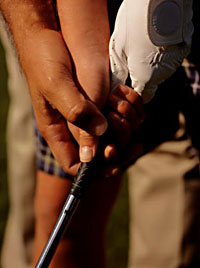
So what are the fundamental swing mechanics we need to be aware of? As a beginner you probably want to start at the beginning which means you want to work on fundamentals. The fundamentals, as you will hear over and over again, include The Grip, The Set-Up, The Stance and Posture, and certain aspects of The Swing just to name a few. All are important but like all details of learning a complex target motion, they should not be thought of as the final goal. They are all just means to an end and pieces of a complex puzzle. As time goes on these techniques will become internalized and made automatic.
The real goal of the swing is hitting the target and the Essense of the Game is to swing the clubhead through the ball to the target. Learning how that feels is the skill we want to aquire. We may break down that action and focus on specific, left brain techniques and practice those techniques but we should remember that making the ball go to the target is the main focus and ultimate goal. Any golfer will tell you that they played their best when they have kept technique thoughts to a minimum and focused on target, target, target. In fact people who have played the game “in the zone” will tell you they were “out of their minds” and not thinking much at all. However, we must build this automatic, thoughtless swing from a foundation of fundamental techniques.
If you watch any great golfer you’ll notice they have each personalized the fundmentals for them. No two golfers swing exactly alike… just as no two fingerprints are exactly alike. The search for the swing thoughts that work for you begins on the range. As you learn about your swing you’ll find different keys that will work for you. Over time you’ll develop a fleet of swing keys that will help you get back on track when your game goes bad. Developing those swing keys is a matter of studying the swing and experimenting with various techniques on and off the course.
What a Beginner Works On
The things a beginner should work on the range will be far different than what a 5 handicap will work on. All the fundamentals are important but there are certain fundamentals that are more important for a beginner.
As in all learning, you must become accomplished in the basics before you can move to more advanced skills. That why it is often difficult for an advanced player to empathize with a beginner because those beginner fundamentals have become so second nature to a good player they can’t relate to how it feels for a beginner. That’s what makes a great teacher. A great teacher is someone who can put themselves in the pupils golf shoes.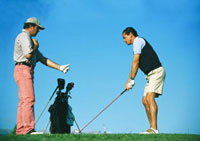
Mastering certain fundamentals will help a beginner get over the initial “hump” they often feel when first playing the game. Making contact with the ball and getting the ball in the air can seem like climbing a mountain to a beginner. Consistency seems like a dream when one shot goes left, the next way right and the next dribbling on the ground. And of course everyone has experienced the occasional dreaded whiff. Nothing creates tension more than a whiff.
And tension is the problem. Overcoming tension is the key to playing your best golf. No matter what level you are at golf, you must battle it.
Even the best golfer, after hitting a bad shot, or facing that crucial putt to win, must stand toe to toe with their inner demons. Part of the lure golf is that it requires direct confrontation with our egos; that part of us that wants to judge every shot, try the impossible, and yet fears failure.
Golf may be the most difficult game of all. The precision required in a difficult golf shot challenges the best athletes in the world, yet anyone is capable of hitting a great shot at any time, and most golfers have. Learning to relax and let yourself hit that great shot is the key and what provides part of the great allure and challenge of golf.
Where does tension come from?
The Ego or Self 1, as Timithy Gellway in The Inner Game of Golf calls it, is the cause of all of our frustrations and tension. That voice inside our heads that is always telling what we should do, what we did wrong and doesn’t really trust us to hit a shot is Self 1. We’ll talk more about confrontations with the Self1/Ego in other parts of the site. As a beginner, just be aware that learning how to manage tension is an ongoing part of learning the game.
Feel the Club Head
Everyone talks about The Swing but what is it that we are actually swinging. The key to accurate contact with the ball and a free relaxed motion is realizing that we are really swinging the club head. It helps to remind ourselves again that the Essense of the Game of golf is ‘swinging the club head through the ball to the target’. That image will free our minds and bodies for optimum performance. 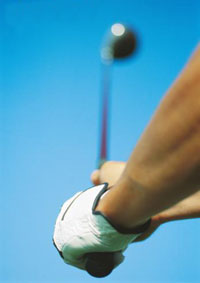
As a beginner, we often get hung up on just trying to hit the ball or make solid contact. People may be watcing. Self 1 is easily embarrassed and hates to look the fool. It becomes easy to lose sight of The Essence.
Even advanced golfers can lose track of The Essence and begin to play the game of ‘trying to hit the ball right.’ “Trying” inevitablly creates tension and leads to more bad shots.
Often, after many bad shots in a row, we give up trying and suprisingly hit a great shot. Once trying is let go, feeling and awareness can return.
The Waggle
So how do we Feel the Clubhead? To begin with we must have a very relaxed grip. Holding the club too tightly will always reduce the sensitivity and feel of our hands. The Waggle is also important. The purpose of The Waggle is to give the brain the feeling of the club head in the hands. To a beginner, the waggle is a strange proposition. Even to someone familiar with baseball or hockey, a waggle may be a new concept. Golf requres more precision than many sports. In golf the the waggle is critical for sensing where the clubhead is and for applying it precisely to the ball.
The Waggle is also hard to describe to someone who doesn’t have one. Like many things in golf it eventually becomes automatic and you may have no conscious awareness that you are doing it— or how you’re doing it. The Golf Bible descibes it as the slow, rhythmic, repetitive movement of the clubhead before the shot with the purpose of creating feel. Next time you watch a tournament on TV, observe how each golfer waggles the club. Each may have their own way of doing it but each definitely has one.
In addition to grip pressure, how the club is held is important. Almost every great instructor will stress The Grip as perhaps the most important of all fundamentals. As it applies to feeling the clubhead, the key point in grip technique is to hold the club in the fingers, particulaly with the right hand for a right handed person. Many beginners hold the club down in their palms and that prohibits club head feel. Holding the club in the fingers promotes much more feel. Try it and you see. Here’s more details about proper grip technique.
Swing Trigger
The Swing Trigger is not something that is talked about very much yet in my opinion it is one of the more crucial aspects of good swing rhythm and a very important beginner fundamental. Beginners often start their swings with a jerky, tense motion. Combined with a good waggle and relaxed muscles, a swing trigger will help reduce tension and create a smooth rhythm.
As you watch many professional golfers you’ll see many variations on the swing trigger. So what it it? The swing trigger is the movement that starts the swing. One example is Jack Nicklaus’ stationary press. He describes it like this.
“By firming up my hands as the final preparatory movement, I get a strong sense of affirmation of the coming swing throughout my body. This simple little device seems to alert all my muscles to the job at hand without tensing them in any way. Thus it has become a critical part of my game, a preface to every shot I play. You should work to build a similarly strong “starter” into your game.”
Other golfers have different triggers. Gary player has that familiar kick of the right knee as does Vijay Singh to a lesser extent. Jordan Spieth does the same thing. Others have a subtle and sometimes not so subtle forward press where there is a sense of the body moving forward and then backward with a smooth clubhead take away into the back swing.
In the video below you can see Jordan Spieth’s swing trigger — an almost imperceptible kick of the right knee.
Harvey Pennick, teacher to Ben Crenshaw and Tom Kite in his Little Red Book had a great visual cue to give people a sense of that motion. Imagine a full pail of water. In order to swing it back smoothly and not spill the water, you must first swing it forward a couple of inches and then you can swing it back. If you try to swing it straight back, you’re bound to do it in a jerky movement and more than likely the water will overflow.
A swing trigger is one of those many things that some beginners aren’t aware of. It’s very seldom taught but all beginners should realize it is critical technique for creating rhythm and consistency. Try it and see.
Pre Shot Routine
Another thing that beginners don’t hear enough about is the Pre Shot Routine. Nothing is more critical for reducing tension and creating consistency. You see it in a tennis serve, a basketball free throw, and a place kickers field goal. In golf having a consistent routine allows the body to be relaxed and fully prepared to hit a good shot. Every good golfer has one and very few beginners have one.
So what is a preshot routine? It’s the series of movements before the swing that prepare the golfer to hit the shot. The waggle, and swing trigger are the final parts of the PSR.
It usually starts with the player standing behind the ball, visualizing the shot to be played and then approaching the ball, aligning the body and the clubhead, the waggle, and the swing trigger. All good golfers have practiced (and continute to practice) their PSR until it is automatic and almost unconcious.
Here’s a video that explains it quite well…
Let’s break down each step.
Visualization
A big part of getting focused on the target is building a strong mental image of the shot to be played. Jack Nicklaus talks about “going to the movies” where he precisely builds a mental movie of the shot, complete with intended ball flight (draw or fade, high or low), the ball landing on the green and rolling to the hole.
It may sound silly but a vivid mental image of the EXACT shot that you want to play is what separates the good from the bad from the ugly shot. Even the best golfers will tell you that they only hit a handful of shots exactly as they envision in a round but a total commitment to trying to achieve a precise shot is what helps eliminate those ugly shots. The difference between a 100’s golfer and a 90’s golfer is not that they hit that many more great shots, they just hit fewer truly ugly shots. A good pre shot routine will eliminate that bottom 20% of your shots.
Alignment
After the mental image has been created from behind it’s time to approach the ball. First make sure your grip is correct. Many players have a precise gripping procedure that is really part of their Pre Shot Routine (Bob Tway) to make sure they are gripping correctly. Make sure you have taken your grip before you approach the ball. At the ball, the clubhead is placed behind the ball square to the target. How do you make sure the clubhead is aligned correctly? Good players do this differently but Jack Nicklaus and Tiger Woods do it the same way. As they stand behind the ball, they pick something a few feet in front of the ball and aligned with the target. It could be a blade of grass an old tee or whatever. When they approach the ball they align the clubhead to that intermediate target. This just prooves how critical clubhead alignment is to the best golfers — and how difficult it can be to achieve. Only after the club alignment is set correctly are the feet and body moved into place parallel to that target line.
Into the Swing
Meanwhile, the body is in constant motion creating rhythm and freeing the body of tension. The waggle frees the hands and arms and moving the body weight from front foot to back foot helps create the feeling of relaxed, tension free readiness.
While you waggle, your mind and eyes move back and forth from ball to target creating the focus required to ‘swing the clubhead through the ball to the target.’ The attention is not on any one thing but feels as if you are trying to collect all of the aspects of the shot together as one; the shape of the shot, the ball, the target, and clubhead alignment. When you finally look at the ball for the last time you still see the target in your mind. Your swing trigger begins the swing, and slowly and smoothly you move the clubhead back into the swing. It’s not rushed. The mind only sees the target. There are no doubts. You stay committed to the shot you visualized.
“Sure,” you say. “Easier said than done. The last thing I’m thinking about is the OB to the right.”
The point is, even though you may not achieve that great shot you envisioned every time, focusing on that perfect shot will free the mind and body to do it’s best. Your percentage of good shots will go up and the number of bad shots will go down. Wether you are a beginner or a pro, a good Pre Shot Routine will improve your game. When you’re on the range try practicing your PSR on every shot.
Short Game Practice
Nothing is more important to practice than your short game — pitches, chips, bunker play, and putting. You’ll often hear instructors say you should devote 50% of your practice time to the short game. The stats show that probably 60-70% of all a beginners shots will be from 30 yards in. It just makes sense to practice those shot. You can take 10 strokes off your game in a month.
So how come beginners never do it. I guess it’s because it doesn’t seem like as much fun. Boring! Actually it doesn’t have to be.
By playing games with yourself you can turn it into fun. Try these:
- See how many times you can get up and down (chip and one putt) out of ten times
- Keep score — how many strokes to go around the putting green
- Get a group of friends and have a “short game” tournament
- Pretent that 5 footer is to win the club championship — or The Masters
Don’t forget to do the same things you do with your long swing. Visualize the shot. Focus on the target. Have a routine, waggle and swing trigger. Your short game will improve quickly.
The correct technique is important too. Beginners often are guilty of trying to help the ball up in the air and end up hitting fat or topped shots. Their instinct tells them they need to scoop under the ball to get it airbourne.
One of the critical things to learn for a beginner is hitting down makes the ball go up. Let the loft of the club do the work. This is true of all iron shots and one of the critical things to realize for a beginner. Practice this technique by pitching balls from about 20 yard from the green with a sand wedge. It’s a great way to get the hang of this principal. Try it you’ll see. Remember, don’ t forget to swing the clubhead
Putting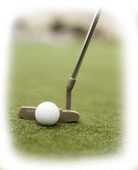
Putting is one of those things that is very personal. Each person needs to develop their own style. Look at the pros. There are more variations on putting style with the pros than you can shake a Two Ball putter at. Everyone learns on the practice green with trial and error.
Just look at all the different kinds of putter types. There’s flat bladed putters, mallet style, belly putters. How about grips. Traditional (Tiger Woods), left hand low (Vijay Singh), the claw (Chris DiMarco), finger down the shaft (Craig Stadler). There is no one putter or technique that everyone agrees upon. It comes down to whatever works. Finding what works and the right club and putting style takes practice and experimentation.
In spite of what I just said, there ARE some things that are common to all good putters. Most good putters keep their eyes directly over the ball. This way it is easy to just tilt your head to see the target line.
Most good putters also keep a VERY steady head throughout the stroke. Peaking (looking up) will move the shoulders and make the ball go offline (usually to the right). In fact, one good swing thought is ‘don’t move your head until you hear the ball go in the hole.’ Watch Annika Sorenstam putt and you’ll see her do this often.
Also having the ususal target oriented preparation is critical.
- View the putt from all sides and particularly from behind
- Have a clear target/shot visualization, a pre shot routine, and a good swing trigger.
- Give the hole a good hard look. Imprint that image in your mind.
And also, don’t forget The Essense; swing the clubhead through the ball to the target with light grip pressure.
On the Course
As a beginner, how do you take the things you’ve learned at the range onto the course. Playing the game on the course requires a bit of a different attitude than on the range. In fact, a good attitude is the key for doing your best on the course no matter what level you are at.
As a beginner, your expectations should be low. Keeping your expectations low will help you relax. Your Ego may want you to have a career best round but in reality, letting go of that expectation will probably give you a better chance of achieving it.
If you’ve never broken 110, accept the fact that it may not happen today. Remember that your score is just the cumulative result of all your shots. If you give maximum focus and relaxation to each shot, within each moment, your score will reflect it. If your attitude is; I will accept and let go of the bad shots and relax and allow the good shots to happen, you’ll find at the end of the round that you’ve hit perhaps your career number of good shots.
Pick Your 5 Favorite Clubs
Here’s another way to take your game from the range to the course. On the range determine which clubs you hit the best.
As a beginner, you’ll probably have at most 5 or 6 clubs that work at all. Probably they will be your 5-9 irons, maybe your wedge, and probably your 5 and/or 7 woods. Generally you’ll find that the higher the loft the easier the club will be to hit. More loft means more back spin and less sidespin. Less sidespin means the ball will go straighter.
When you go to the course, vow to hit ONLY those clubs. You’ll be tempted to hit a driver, but as a beginner your 5 wood will probably go just as far and much straighter. If you commit to hitting just your best 5 clubs I bet you will take 5-10 strokes off your score.
Make Your Own Par
Someone decided that on a typical par 3 it should take one shot to get to the green, on a Par 4 two shots, and a Par 5 three shots.
Remember, this is not actually a rule…more of a guidline. Beginners should totally ignore this guideline and make their own par.
Attitude On The Course
If you’re a beginner you’re probably anxious to get on a golf course and “play” the game. Why not. That’s where all the fun is and where the true joy of the game is experienced. However, this can be a scary thought for a beginner for a lot of reasons. For one, you might be intimidated by other golfers who are better than you. For that matter you may be uncomfortable just because you don’t know much about playing the game on the course. You may not know what to do, where to stand, when to talk, etc. You may not understand what golfers call the “etiquette” of the game.
How To Play With People
I’ve been playing golf for over 40 years and play to a 5 handicap and when I get hooked up with a beginner we often have an awkward time until we get to know each other. 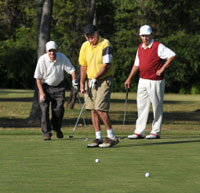
I get the feeling that many beginners, and intermediate golfers for that matter, feel they may somehow effect my game. They think that when they hit a bad shot it will influence my shots and my game will suffer. They often apologize for a bad shot as if their “curse” would somehow be transferred to me.
Let me announce to all beginners and intermediate golfers that your golf game has no effect on my or any other good players game.
On the other hand there are many things that you do that can effect my game and can actually effect my score. The good news is most of these things have nothing to do with how good you are at golf. And don’t feel bad. There’s no way you could know many of these things unless someone tells you. I’m here to help you understand what they are.
Good golf requires a certain atmosphere. Now I know this may sound a bit pretentious but it’s true. As you are finding out, hitting that little white ball solidly and towards your target takes quite a bit of concentration and focus. To maintain that focus a golfer needs no distractions. These include auditory and visual distractions.
Keep it down please
Therefore please refrain from conversation and loud sounds during a players shot. That includes the time before the shot which is called the pre-shot routine. That routine lasts about 10-15 seconds for most golfers. During that time a golfer is focusing on their target, visualizing the target line and preparing his/her body to hit the shot. They are breathing slowly and relaxing so that tension will not interfere with the shot. This state of relaxed concentration is difficult to maintain.
Visual distractions can include movement anywhere within the peripheral vision of the golfer. This particularly includes along the target line forward and behind the ball. This is especially true on the greens. On the green, please don’t leave your ball around the hole or stand behind a golfer on their target line. For a good golfer those are major distractions. When you take the pin out of the hole and put it on the green, please don’t put it behind the hole on someone’s target line or anywhere near it within about 20 feet. Ideally put it down somewhere off the green.
Pace of Play
Another important factor is pace of play. Once concentration has been established and a rhythm has been found, a good golfer wants to maintain that rhythm. Waiting extended periods for other golfers is not helpful to that rhythm. By all means you have a right to play your game, but maintaining the pace of play and not holding up other members of your group is a cardinal rule of playing on the course. Nothing will effect a golfers game more than unneccessarily slow play.
If you find that your score on a hole is approaching par times 2 (8 on a par 4) that is a good time to pick up and sit out the rest of the hole. If you are facing a very difficult shot that you probably can’t pull off, why not give it one try and then move on. It’s certainly OK to give it a try but don’t waste time “practicing” at other golfers expense.
The pace factor becomes even more important when there is a group behind you that is playing at a faster pace. A good player who has played many rounds knows when the pace is slow especially when he sees the group behind waiting on every tee and on every approach shot. Sensing the frustration of the group behind you is a definite concentration wrecker. Either pick up the pace or let the group play through.
These are the most important things to know. To summarize:
1. Don’t distract another player with noise or movements while they are playing a shot
2. Play at the pace of the overall group or pick up. Sometimes a course marshall will remind you when you are playing slowly.
That’s really all there is to playing golf in a courteous and friendly way. By all means have fun and play your game but be aware of how your actions effect other players. Believe me you’ll also play better and enjoy the game more too.

